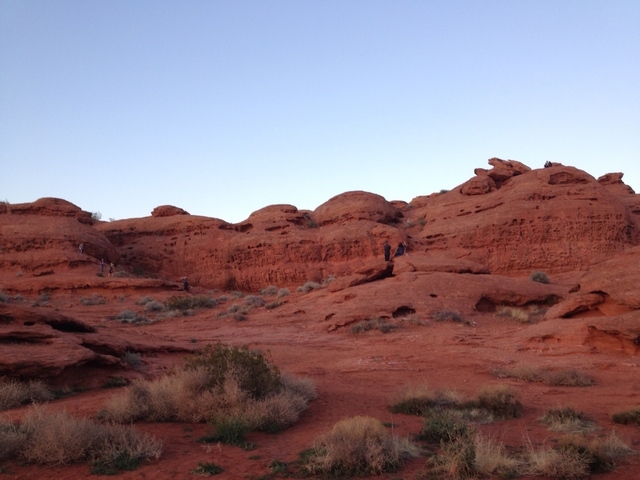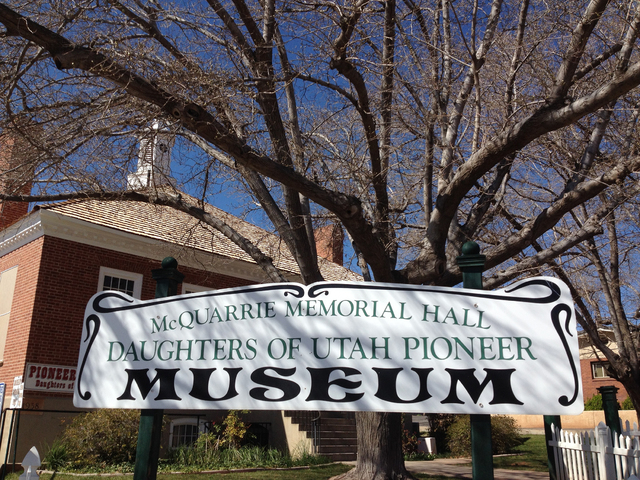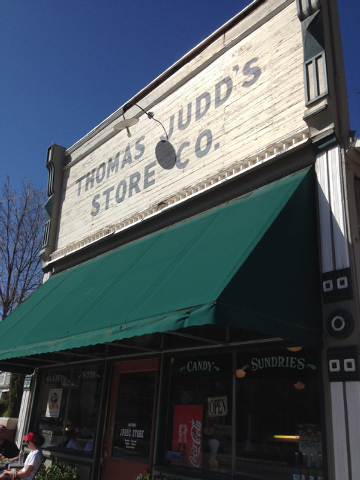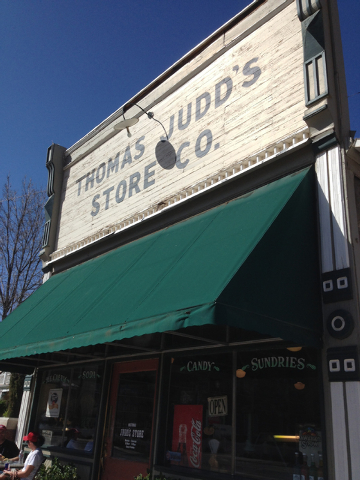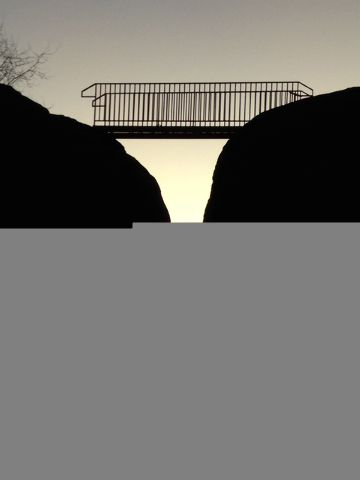Pioneer history comes alive in St. George, Utah
Standing on the red cliffs overlooking St. George, Utah, you can imagine this valley as the area’s first white residents saw it 150 years ago.
It helps that the city skyline is still dominated by the impossibly white Mormon temple and the church’s brick tabernacle, topped with its white spire.
They were the first major things built by those Mormon settlers, who didn’t come here to the dry, hot southwestern edge of Utah by choice.
They were sent to grow cotton.
The small but impressively packed Daughters of Utah Pioneers museum, behind downtown’s historic courthouse, is a good place to start understanding how those settlers lived.
The museum’s glass cases and display tables host hundreds of exhibits, including kitchen tools, homemade clothes spun from the cotton they grew and the primitive-looking tools used to simultaneously build the nearby temple and tabernacle.
You quickly come to understand the ingenuity people used in making a city — and a life — in such a harsh environment.
“I tell you, I don’t know how they did it,” volunteer Pat McCrary said as she showed off some of the home appliances. “I need my microwave and my dishwasher and my washing machine.”
The region around St. George has long been known as Dixie “because it was hot, southern and produced cotton,” as “A History of Washington County” puts it.
Today, Interstate 15 runs through the area, and the outskirts of town have the same fast food and shopping chains as everywhere else. The tourist traffic and growing population have brought more diverse restaurants downtown.
“Dixie has been quite thoroughly Americanized, but its pioneer heritage is still in evidence,” Douglas D. Adler and Karl F. Brooks write in the county history book.
What that means, among other things, is you can spend a day enjoying the history but also have some excellent sub-$2 chorizo tacos for lunch, then sushi or Thai food for dinner. Because, after all, what’s more American these days than Mexican food or sushi?
Then you can overlook it all from back in your room at Inn on the Cliff. The two-story inn, just west of downtown, opened last year after a complete renovation.
The rooms are motel style but luxurious. All 27 overlook the valley and have sweeping views of the surrounding mountains, which include the Pine Valley range.
St. George’s small, walkable downtown is dotted with bronze statues both historic (Abe Lincoln, Brigham Young) and whimsical (kids playing in a circle, a little boy holding a fish). Oddly, most were for sale.
Most of downtown’s best attractions — including the pioneer museum, the Mormon tabernacle and temple visitors center, Brigham Young’s winter home — are free to tour. That’s because most are owned by the Mormon church, with friendly church members — including missionaries from around the world — leading tours.
The DUP museum and some other attractions are closed Sundays, so if you’re making a weekend of it, save the tabernacle and the Young house for Sunday.
Only members of the church can go inside the temple, but anyone can tour the tabernacle. It was started in 1863 and dedicated in 1875 — construction slowed once building of the temple began in 1871.
Most of it is original, including the hardwood floors and the free-standing spiral staircases, which took two years to build. At first glance, much of the material appears to be various hardwoods, and the huge columns look like marble. But almost all of it is painted pine — they made do with what they had.
Amazingly, settlers started building the tabernacle before some of them had homes to live in. They slept under their wagons as they built a church. Call that dedication to your faith or something else; either way, it’s impressive.
Downtown has several fun stores to browse, including Judd’s, whose sign says it’s the oldest shop in town. It sells old-fashioned candy and sodas, along with soup, sandwiches, nachos and ice cream.
Urban Renewal on St. George Boulevard contains a quirky hodgepodge of handmade goods, custom furniture, vintage clothing, consignment items and what claims to be the city’s only record store. For Vegas visitors, the flat fee to deliver anything (even an L-shaped custom couch) is $50.
For lunch at The Twisted Noodle, try the sun-dried tomato cilantro turkey burger or the sesame chicken wrap, which looks like a giant burrito (or a small pet). And get the thin and crunchy veggie chips, which taste homemade.
A little before sunset, head to Dixie Sugarloaf, a red rock north of town so known because “DIXIE” is painted on it in white. (Not only is that the area’s nickname, but Dixie State University is nearby.)
Offering an impressive view of the valley, it’s a popular spot for couples and families, some of whom bring a box of pizza to eat as kids (and adults) scamper around the rocks.
For dinner, assuming you’re saving those chorizo tacos for lunch, you can pick from a cluster of restaurants around St. George Boulevard and Main Street. Benja Thai &Sushi’s name is self-explanatory. The pricier Painted Pony has entrees including bacon-wrapped duck and rack of lamb. George’s huge menu includes burgers, ribs and sandwiches.
A short drive away, the temple’s peaceful grounds are open to all at night, a time when the lighting makes the building look especially beautiful.
After that, you can return to your air-conditioned room at Inn on the Cliff, with its plush Simmons mattress and mint truffles on the pillows. But imagine, for a second, coming here with no place to live, one of those 309 families selected for their professions and the skills they’d bring to building a church or growing cotton.
“If you just find me a flower, I’ll stay,” one miserable woman is said to have told her husband after seeing the desolate landscape that’s now St. George. (In another version, it began, “Show me one thing of beauty ...”)
He found her a flower, but it might have been the only one.
Yet for today’s visitor the area’s beauty stands out, as does the independent spirit of its early residents.
Adler and Brooks write that St. George’s isolation spawned homegrown culture: bands, choirs, dances, literary societies and theater. There were even newspapers, a modest library and schools.
Much later, air-conditioning and especially I-15, completed through the area in 1973, changed things dramatically. Retirees and new companies have helped the county population — now about 148,000 — triple just since 1990.
But the past is present here. The tabernacle, which seats 800, still hosts free music and civic events regularly.
Quite a contrast to Las Vegas, where a hotel that opened in 1955, the Riviera, is considered ancient — and slated for destruction in a few months.
Instead of imploding its history, St. George lives in it.
IF YOU GO
Getting there: Driving to St. George from the Las Vegas Valley is simple: Take I-15 north for a little less than two hours. Head through Arizona, and start getting toward the right lane once you get into Utah. Your exit number will be around 6 or 8, depending on where you’re heading.
Eating: Cheap authentic tacos — especially the chorizo — at the no-frills El Coyote Charro, 969 N. 3050 East. Open for lunch and dinner; call 435-627-6782.
The Twisted Noodle, 20 N. Main St., has wraps, salads, soups, sandwiches. Owned by chef Cameron Moore, who has worked in Las Vegas. 435-628-9889
Sushi and Thai food at Benja Thai & Sushi, 2 W. St. George Blvd. It can get busy for dinner; call 435-628-9538 for more.
Visiting: Daughters of Utah Pioneers Museum, 145 N. 100 East. 435-628-7274. Free tours from 10 a.m. to 5 p.m. No photos allowed inside. Closed Wednesdays and Sundays and all of December.
St. George Tabernacle, 490 S. 300 East. Open for free tours daily until dusk; call 435-628-4072 for details.
St. George Utah Temple, 250 E. 400 South. The visitors’ center is open to all, but Mormons consider the inside of the temple a sacred spot, so it’s not open for tours. 435-673-3533
Jacob Hamblin Home, 3325 Hamblin Drive, Santa Clara (about a 15-minute drive from downtown St. George). The former home of a man known for making peace with Native Americans is open daily for free tours; call 435-673-2161 for details.
Dixie Sugarloaf, part of Pioneer Park. Head north out of town, then east on Red Hills Parkway. You’ll see one parking area on your left for Sugarloaf, then another for the rest of Pioneer Park. Choose either and explore.
Staying: Inn on the Cliff, 511 S. Airport Road. 435-216-5864 or innonthecliff.com. Luxurious rooms in an unpretentious setting, with friendly staff who’ll bring you whatever you need. That includes free breakfast — one you wouldn’t mind paying for — delivered to your room every morning.
About those street names: East and South at the same time? 400? 200? It all sounds odd if you’re not used to Utah, but Google will guide you.



